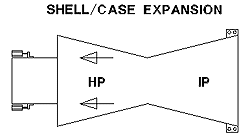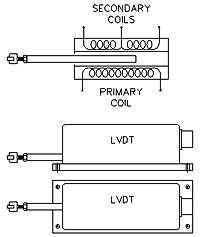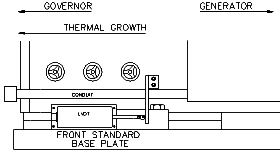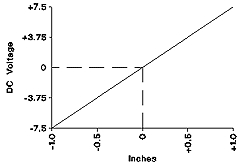Shell or Case Expansion is a very important
measurement as part of a Turbine Supervisory Instrumentation (TSI) System for large steam
turbines. This measurement should be included in turbine retrofit plans when at all
possible.
 The Shell Expansion measurement is utilized by operators to monitor the proper
thermal growth of the turbine's shell during startup, operation, and
shutdown. The turbine's shell is anchored to the foundation at one end of the machine and
allowed to expand or grow by sliding towards the opposite end. The expansion or growth of
the turbine's shell Shell Expansion is the measurement of how much the turbine's shell
expands or grows as it is heated. As large turbine cases grow or expand thermally, in some
case up to several inches, and was usually supplied as part of the Original Equipment
Manufactures TSI system supplied with the turbine. The Shell Expansion measurement is utilized by operators to monitor the proper
thermal growth of the turbine's shell during startup, operation, and
shutdown. The turbine's shell is anchored to the foundation at one end of the machine and
allowed to expand or grow by sliding towards the opposite end. The expansion or growth of
the turbine's shell Shell Expansion is the measurement of how much the turbine's shell
expands or grows as it is heated. As large turbine cases grow or expand thermally, in some
case up to several inches, and was usually supplied as part of the Original Equipment
Manufactures TSI system supplied with the turbine.
Used in conjunction with a Differential Expansion (DE) measurement (Case to Rotor) the
thermal growth of both the case and rotor can be monitored to prevent costly rubs between
the rotating and stationary parts of the turbine.
The recommended Shell Expansion measurement device is a CMCP LVDT (Linear Variable
Differential Transformer) engineered and manufactured to provide long measurement ranges,
long life and simple installation.
Both retrofit and new applications may be
accommodated easily with CMCP LVDT design
as it incorporates a protective epoxy coated aluminum housing with mounting flanges and a
spring loaded plunger with an adjustable roller tip.
Occasionally due to improper turbine shell pre-heating, maintenance or the location of
the steam inlets being used to preheat the turbine the turbine shell may become distorted
which can cause internal damage.
 Turbine "Cocking" occurs when the turbine sliderhangs up or sticks on one side of the foundation and continues to grow or slide on
the other. This condition sometimes corrects itself by breaking loose quite
dramatically. To monitor for distortion or cocking two (2) LVDT's may be utilized and are installed on either side of the Front Standard or turbine case. If the Turbine Case does
not grow evenly the case is allowed to cool and then reheated with more even heat
distribution. Turbine "Cocking" occurs when the turbine sliderhangs up or sticks on one side of the foundation and continues to grow or slide on
the other. This condition sometimes corrects itself by breaking loose quite
dramatically. To monitor for distortion or cocking two (2) LVDT's may be utilized and are installed on either side of the Front Standard or turbine case. If the Turbine Case does
not grow evenly the case is allowed to cool and then reheated with more even heat
distribution.
Theory of Operation

LVDT's are electromagnetic devices that have three coils
of wire wound on a hollow tube and a metal rod moving inside the hollow tube. The primary
coil of wire is excited by a supply voltage which induces a voltage in the other coils as
t&he rod or plunger travels throughout its range. When the plunger is centered in its
range the induced voltage of the two secondary coils is equal in magnitude, but opposite
polarity. As the plunger moves to either side of the center position the voltage of one of
the secondary coils increases while the other secondary coil experiences a decreased
voltage. DC LVDT's differ from AC LVDT's in that they are manufactured with an internal
carrier generator/signal conditioning module and only require DC Power to operate.
Special Considerations
Operating Range
The standard CMCP LVDT has a standard operating range of 1.0, 2.0 or 4.0 inches. The
most common used is 0-2 inches (0-50 mm) with an output of (-7.5)-0-(+7.5) VDC and an
accuracy of ±0.5 % full scale. A shorter range may be selected by using the center
portion of the LVDT standard operating range. Longer ranges are available on request.
Transducer Installation
The body of the LVDT is designed to be rigidly attached to the turbine foundation and the
spring loaded roller tipped plunger is to press against a bracket that is attached to the
Front Standard or Turbine Case.

The bracket must be designed not to interfere with turbine operation and allow the roller
tip of the plunger to ride against freely it throughout the entire range.
Measurement Convention
The CMCP LVDT operates on the standard instrument
convention that as the plunger or rod is compressed into the LVDT body (motion towards the
transducer) the signal output increases or goes more positive. The LVDT may be installed
in either direction so that thermal growth causes a more positive going signal or a
negative going signal. The monitoring system can be configured for either direction.
Conduit
Dedicated TSI System conduit should be provided in all installations for
mechanical protection of the instrument cable. Rigid IMC conduit is required from the
monitor location to the LVDT location. The final 2-3 feet of the conduit installation
should be completed with flexible conduit to facilitate transducer removal. The
CMCP LVDT body is equipped with a 3/4" NPT conduit fitting.
Instrument Wire
For LVDT applications a 4-conductor, twisted, shielded,
insulated, instrument wire should be utilized between the monitor location and the LVDT.
This wire should be a continuous run and not be spliced. Alternately two (2) individual
twisted, shielded pair wires may be used with extreme care taken to properly tag the
cables to prevent improper connection.
The following wiring connection convention should be followed:
| Red |
-18 VDC |
White |
Signal |
| Black |
Power Ground |
Green |
Signal Ground |
The following Belden Part# have been provided for your convenience. They may be cross
referenced to other wire manufactures.
| Belden Part Numbers |
|
Pair Nom.
O.D. |
4-Cond. Nom.
O.D. |
| 18 AWG |
8760 |
0.22" |
9418 |
0.25" |
| 20 AWG |
8762 |
0.20" |
N/A |
 Calibration Calibration
The CMCP LVDT is designed to be installed so that when the plunger is centered
in its operating range the LVDT output voltage will be 0 VDC.
This calibration may be accomplished by temporarily inserting a block whose thickness is
equal to exactly one-half (1/2) the desired range (for 2" range use a 1.0"
block) under the plunger tip when the turbine case is in it's cold position and adjusting
the roller tip, located at the end of the plunger, until 0 VDC is obtained at the
transducer output. Alternatively, the entire body of the LVDT may be repositioned.
Shell Expansion Checklist
- Number of LVDT,s, One Two
- Operating Range
- Transducer Location(s)
- Measurement Convention
- LVDT Installation Documented
- Correct Instrument Wire
- Metal IMC Mainline Conduit
- Flexible Conduit
- Calibration
|

